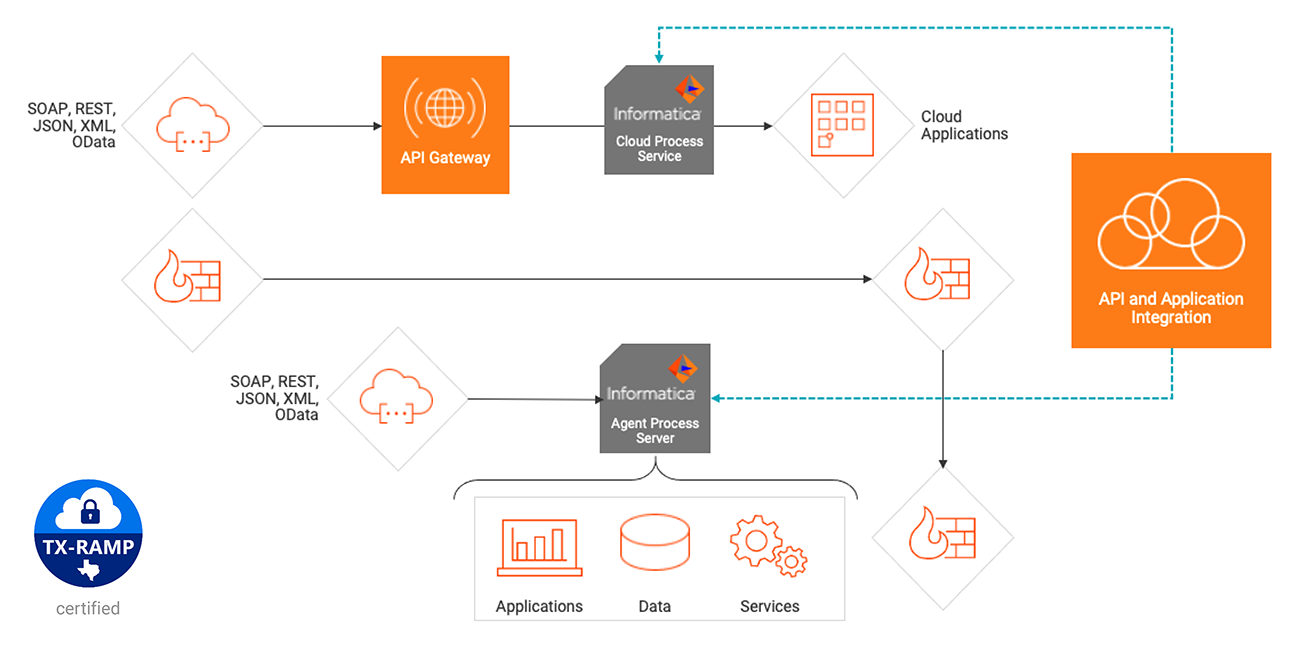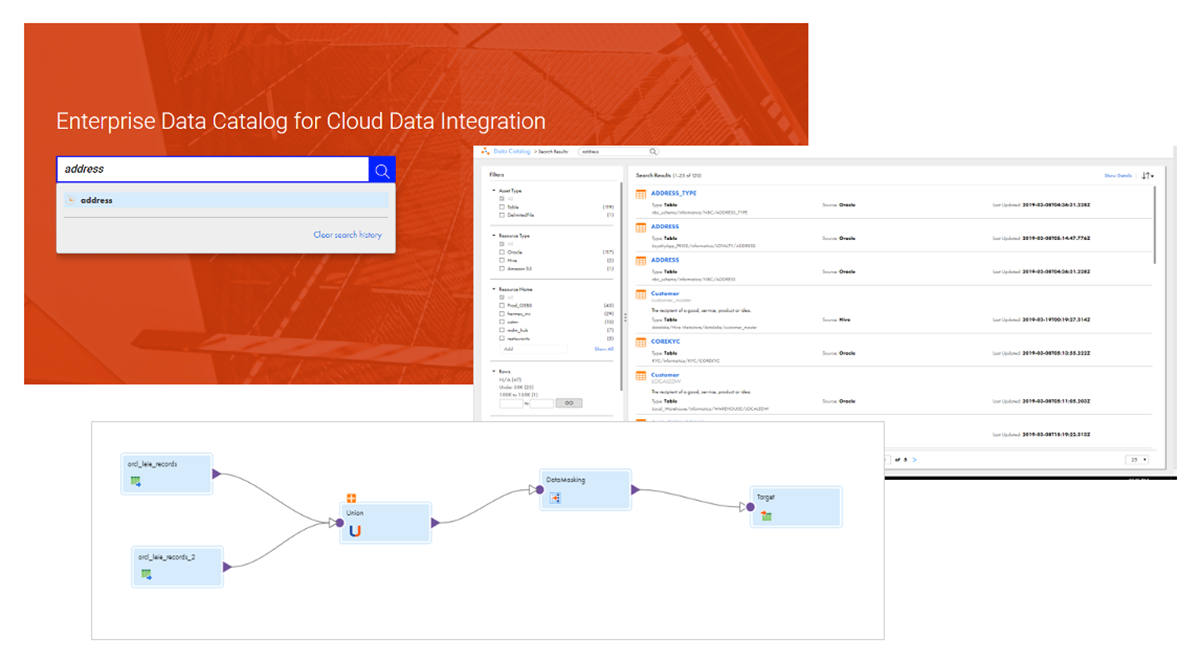Intelligent Cloud Data Management for Government TX-RAMP Requirements
Government organizations use data to create valuable insights about their services, operations, resources and, increasingly, to make data available to citizens. To drive innovation, uncover efficiencies, and help refine processes, agencies are modernizing their operations and seeking new ways to use intelligent data. By moving to the cloud, agencies can take advantage of the most advanced technology available while eliminating the upfront capital expense of buying hardware and software, and removing the burden of software setup, maintenance, and upgrades.
But volumes of legacy data that reside on-premises and in the cloud tend to be siloed, poorly integrated, and lacking governance. Moving to the cloud doesn’t solve the integration and management challenges of digital transformation, it amplifies them—exponentially. Unfortunately, defaulting to traditional data and application integration techniques designed for legacy on-premises data warehouses and applications won’t work for cloud. If agencies plan on gathering, storing, and integrating massive amounts of different data types from various sources and want to support multiple new and unique integration patterns—including real-time application integration, data synchronization, and more—they will need a cloud-native, automated, intelligent, and comprehensive solution.
Informatica has achieved a TX-RAMP Level 2 certification for the Informatica Intelligent Cloud Services (IICS) platform. With this designation, Texas government agencies can now leverage the industry-leading platform within the Government Cloud environment. Doing so will empower agencies to dramatically reduce the time required to ingest or integrate data and applications, and enable them to quickly connect to cloud, multi-cloud, and on-premises data sources and applications. Many of the world’s leading organizations in highly regulated industries such as financial services and healthcare currently deploy IICS at scale in mission-critical enterprise environments.
Government agencies will have complete access to IICS to rapidly catalog and integrate multi-cloud and on-premises data and applications. IICS provides access to clean, secure, governed data for analytics at cloud scale and speed, and accelerates and streamlines modernization to cloud data warehouses and data lakes. These capabilities will help agencies meet the rising demand for citizen services, comply with regulatory mandates, and achieve their operational data-driven outcomes.
The TX-RAMP program provides a standardized approach to security assessment, authorization, and continuous monitoring for cloud products and services. IICS already meets, is aligned to, or can be used in compliance with a number of global security standards, including General Data Protection Regulation (GDPR), California Consumer Privacy Act (CCPA), AICPA SOC2 Type II and SOC3, Health Insurance Portability and Accountability Act (HIPAA), ISO27000, Cloud Security Alliance (CSA), and Salesforce AppExchange.
Key Benefits
- Fully managed service with continuous, automatic system updates in the cloud
- Supports many unique and next-gen integration patterns, all data types, and personas for a multi-cloud world
- Performance, scalability, flexibility, and reliability to fuel digital transformation
Key Features of the TX-RAMP IICS
TX-RAMP IICS is a microservices-based, automated, AI-powered, and cloud-native data management solution. All of the TX-RAMP IICS components and integrated Informatica solutions described below incorporate the CLAIRE® artificial intelligence (AI) and machine learning engine, which leverages industry-leading metadata capabilities to accelerate and automate core data management and data governance functions.
Cloud Data Integration
Built on a next-generation, microservices-driven software as a service (SaaS) platform, Informatica Cloud Data Integration enables you to connect to industry-leading applications and data sources across on-premises and the cloud and allows you to integrate the data sources at scale. Optimize the performance of your development teams by employing a codeless UI to build new integrations using drag-and-drop interfaces, making complex integrations simple. Speed up new initiatives with pre-built templates to get teams up and running more quickly, even for very involved scenarios.

As an added bonus, you can enable other teams across your organization to improve integrations by leveraging specially built wizards for completing the last mile of integrations. Optimize the performance of the integration jobs by leveraging integration features built for the data warehouse and data lake. Take advantage of optimized connectors for bulk loads of billions of records. Convert ETL to ELT jobs by enabling pushdown optimization that converts your workloads to optimized SQL code.
Automate and speed up your workloads to cloud data warehouses and data lakes with out-of-the-box solution templates tailored for cloud data warehouses like Amazon Redshift, Microsoft Azure Synapse Analytics, and Snowflake.
Cloud Application Integration and API Management
Accelerate your mission, drive innovation, and create efficiencies by intelligently connecting any application and any data that resides on-premises, such as SAP, Peoplesoft, or Oracle, and in the cloud, such as Salesforce, Marketo, or NetSuite. Create and automate processes and expose these as APIs.

Define application, data, and process APIs quickly using a graphical designer to expose REST and SOAP APIs. Orchestrate, ingest, synchronize, replicate, and transform any data, from cloud or on-premises sources (inside or outside your firewall), at any speed and with any latency, using a single, modern, and intelligent API platform. Publishing a process automatically generates APIs—no need to worry about protocol details. Interface documents developers use to access your APIs are generated to drive up productivity.
Expose consumed events as APIs to leverage these processes and provide access to cloud and on-premises data via APIs, at any latency. Integrate message- and event-based systems, queues, and topics such as Kafka, JMS, AMQP, AWS SNS/SQS, Azure Service Bus, and many more. Choose from out-of-the-box connectors or define your own to consume data and logic from any source.
Cloud Application Integration provides you access to the execution state and data of each process instance to provide complete visibility. If an error is caught, the process automatically suspends it and you can resume its execution when the problem is corrected.
The service supports developers as well as any tech-savvy, non-technical user such as citizen integrators, business analysts, and IT operators with a zero-code tool. Users can create orchestrations using sequential, parallel, and conditional steps to expose application, data, and event APIs, perform real-time data integrations, and automate processes.
With Informatica’s integrated, graphical design environment, no coding is required. The TX-RAMP IICS provides API management (APIM) through its integration with major cloud solutions such as Microsoft Azure Synapse Analytics, Amazon Web Services, Google Cloud Services, and other partner offerings. The APIM integration enables agencies to design, secure, analyze, and scale APIs anywhere with visibility and control. Agencies can also monitor APIs to ensure API availability to maintain seamless experiences for application developers and partners.
Enterprise Data Catalog
With integration embedded directly into the TX-RAMP IICS, the Informatica Enterprise Data Catalog enables you to accelerate development with landscape visibility, so you can rapidly find and use data to drive mission outcomes. Auto-scan agency assets, whether on-premises or in the cloud, to achieve end-to-end data lineage. Reduce reliance on IT with profile, value frequency, and similarity analysis for 360-degree asset understanding and usage.
Leverage machine learning to catalog and classify metadata attributes for ease of discovery by business and technical users. Impact analysis reporting streamlines debugging and re-use tasks and optimizes cloud migration. The Enterprise Data Catalog also accelerates self-service integration in the TX-RAMP IICS mappings and synchronization tasks, thanks to out-of-the box integration of technical metadata with other Informatica solutions.

With the Enterprise Data Catalog, you can capture, identify, and explain where data is used, where it originates from, and how it changes from source to report, including where data quality initiatives have been implemented. In addition, you can eliminate costly one-off, manual workarounds to document metadata information for business use.
Tight Integration With Enterprise Data Governance
The Enterprise Data Catalog in turn integrates tightly with Informatica’s Enterprise Data Governance solution, which enables definition of business glossary terms, policies, and classifications and automatically associates them with the right technical metadata. By combining that with similar data and subsets of data, the solution lets you identify all of the places across all of your organization’s systems where relevant related data is captured, stored, and used. Leveraging the power of AI and machine learning, Informatica lets you quickly discover all of your critical data assets so you can see how they impact your enterprise data governance program, understand the context surrounding the data, and build trust in your well-governed data.
With Informatica’s Enterprise Data Governance Solution, it’s easy to define, monitor, and automate data quality rules from within Axon™ Data Governance, which is a component of the solution. Users can profile, standardize, manage exceptions, and cleanse and monitor their own critical data. The solution also allows users to monitor data quality in real time by setting their own rules for measuring data quality and then viewing these metrics through easy-to-understand dashboards in Axon Data Governance.
Informatica delivers the most scalable, automated, intelligent solution for fast, agile data governance. And when your data analysts, data stewards, and others can find, understand, and collaborate on more data more intelligently in less time, your entire agency can accelerate its digital transformation initiatives.
Next Steps
Informatica has achieved a TX-RAMP Level 2 certification for the Informatica Intelligent Cloud Services (IICS) platform. With this designation, Texas government agencies can now leverage the industry-leading platform within the Government Cloud environment. Visit Informatica’s Data Management Solutions for Government Agencies site to learn more.





